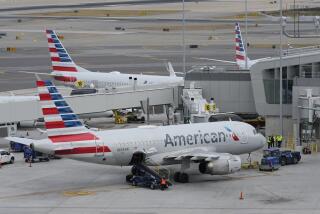Fly or drive – what’s the better deal?
Who would take a road trip when gasoline is hovering near $4 a gallon? Well, you might, especially if you’re taking the family.
Sometimes it’s cheaper to drive. “Driving makes sense if you have three people traveling, heavy baggage or fragile sporting equipment,” said George Hobica, founder of Airfarewatchdog.com, an airfare deals blog.
Baggage fees, which put almost $3.4 billion into airlines’ coffers last year, can cost as much as $35 a bag (Allegiant, paid at the airport), so if you’re a family of four, each with a checked bag, you have added $140. A 75-pound bag can set you back as much as $175 on Delta or US Airways. That’s before you’ve even left the ground, never mind if something happens and you have to change your tickets (as much as $150 a ticket for a domestic flight, $250 a ticket for international).
You can also eschew the car for Amtrak or Greyhound, which offer discounts for buying fares in advance along with other deals. And you need not rent a car when you get there if you choose a pedestrian-friendly city such as San Francisco, Portland or downtown Denver. Look for promotions, too, that can help you vacation vehicle-free: San Luis Obispo (www.slocarfree.org/discounts/) and Santa Barbara (www.santabarbaracarfree.org) can save you 20% on Amtrak, along with discounts on hotels, activities and more.
If you do choose the car route, you’ll be able to save some money (and wear and tear) by following these tips from Steve Mazor, manager of the Automotive Research Center of the Auto Club of Southern California, and Robert Hills, education manager at the Universal Technical Institute, an automotive technology school in Phoenix. Some of them may not be popular with your passengers, so use at your discretion.
To save money, cruise at 60 mph when you’re on the highway (assuming conditions and the speed limit allow). Each 5 mph you drive over 60 is the equivalent of paying 30 cents more per gallon, the U.S. Department of Energy reports on its fuel economy website, https://www.fueleconomy.gov.
At freeway speeds, roll up the windows and turn on the air conditioning. The drag created by having the windows down reduces gas mileage. At low speeds, do the reverse, unless it’s a hot day and your passengers threaten to mutiny.
Skip the drive-through to avoid engine idling. “Instead of going through the drive-through teller or fast-food joint, park and walk into the business, get some exercise and save gas,” Mazor said.
Anticipate obstacles. Listen to traffic reports or use the traffic service on your GPS to alert you to slowdowns, then reroute yourself. If you do get stuck in traffic, stop and start smoothly rather than racing to make up for lost time. Imagine that you have an egg between your foot and the accelerator and you don’t want to break it. Accelerating slowly can save 10 times as much fuel as a jack-rabbit start.
Anticipate obstacles, Part 2. If it’s something as minor as a red light, “take your foot off the pedal, coast and often the light will turn green by the time you are actually there,” Mazor said.
Plan your route. Getting lost is a time and fuel waster (hello, GPS). If you’re staying in a hotel or motel, try to identify eating spots nearby that allow you to walk off dinner or, at the very least, avoid getting back in the car.
Inflate your tires properly and check them monthly. Yes, we know you already knew that. But did you know you lose up to 2% of fuel economy for every pound that your tires are underinflated? Plus underinflation puts more wear on your tires.
Change the oil regularly. Follow the auto manufacturer’s recommended maintenance schedule, including the fuel filter.
Don’t waste money on premium fuels if your car doesn’t need them. Using premium fuel if it’s not called for is like setting dollar bills on fire. We don’t recommend it, especially at a gas station.
Don’t carry extra junk in your trunk. You’ll be surprised at how that extra bag of kitty litter can cut into fuel economy.
Look for something better than cheaper gas: free gas. Nicole Hockin, author of the TravelSmart blog (sponsored by Hotels.com), recommends finding hotel deals — and there are many of them this summer — that offer gas cards. Some grocery stores also are offering fuel discounts and bonus shopping points tied into their rewards programs.
Go online to help keep your costs in line. Check out some of these websites to figure your gas costs or to find cheaper gas:
https://www.fuelcostcalculator.aaa.com
More to Read
Sign up for The Wild
We’ll help you find the best places to hike, bike and run, as well as the perfect silent spots for meditation and yoga.
You may occasionally receive promotional content from the Los Angeles Times.






